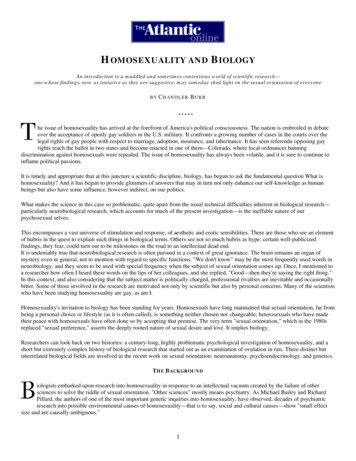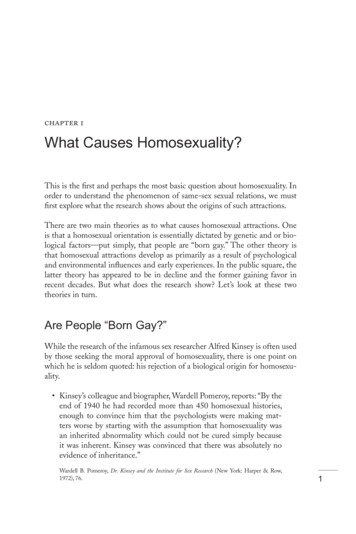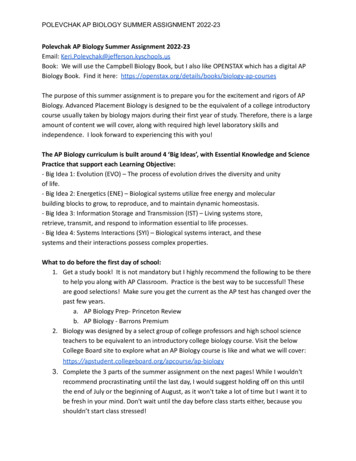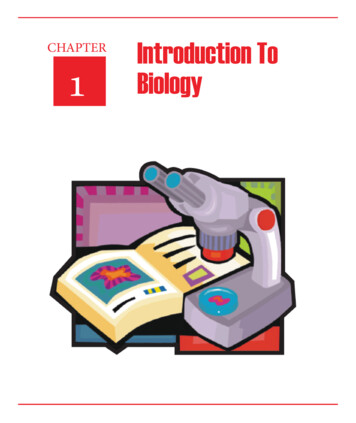
Transcription
HOMOSEXUALITY AND BIOLOGYAn introduction to a muddled and sometimes contentious world of scientific research—one whose findings, now as tentative as they are suggestive, may someday shed light on the sexual orientation of everyoneBYC HAND LER B U RR.he issue of homosexuality has arrived at the forefront of America's political consciousness. The nation is embroiled in debateover the acceptance of openly gay soldiers in the U.S. military. It confronts a growing number of cases in the courts over thelegal rights of gay people with respect to marriage, adoption, insurance, and inheritance. It has seen referenda opposing gayrights reach the ballot in two states and become enacted in one of them—Colorado, where local ordinances banningdiscrimination against homosexuals were repealed. The issue of homosexuality has always been volatile, and it is sure to continue toinflame political passions.It is timely and appropriate that at this juncture a scientific discipline, biology, has begun to ask the fundamental question What ishomosexuality? And it has begun to provide glimmers of answers that may in turn not only enhance our self-knowledge as humanbeings but also have some influence, however indirect, on our politics.What makes the science in this case so problematic, quite apart from the usual technical difficulties inherent in biological research—particularly neurobiological research, which accounts for much of the present investigation—is the ineffable nature of ourpsychosexual selves.This encompasses a vast universe of stimulation and response, of aesthetic and erotic sensibilities. There are those who see an elementof hubris in the quest to explain such things in biological terms. Others see not so much hubris as hype: certain well-publicizedfindings, they fear, could turn out to be milestones on the road to an intellectual dead end.It is undeniably true that neurobiological research is often pursued in a context of great ignorance. The brain remains an organ ofmystery even in general, not to mention with regard to specific functions. "We don't know" may be the most frequently used words inneurobiology, and they seem to be used with special frequency when the subject of sexual orientation comes up. Once, I mentioned toa researcher how often I heard these words on the lips of her colleagues, and she replied, "Good—then they're saying the right thing."In this context, and also considering that the subject matter is politically charged, professional rivalries are inevitable and occasionallybitter. Some of those involved in the research are motivated not only by scientific but also by personal concerns. Many of the scientistswho have been studying homosexuality are gay, as am I.Homosexuality's invitation to biology has been standing for years. Homosexuals have long maintained that sexual orientation, far frombeing a personal choice or lifestyle (as it is often called), is something neither chosen nor changeable; heterosexuals who have madetheir peace with homosexuals have often done so by accepting that premise. The very term "sexual orientation," which in the 1980sreplaced "sexual preference," asserts the deeply rooted nature of sexual desire and love. It implies biology.Researchers can look back on two histories: a century-long, highly problematic psychological investigation of homosexuality, and ashort but extremely complex history of biological research that started out as an examination of ovulation in rats. Three distinct butinterrelated biological fields are involved in the recent work on sexual orientation: neuroanatomy, psychoendocrinology, and genetics.THE BACKGROUNDiologists embarked upon research into homosexuality in response to an intellectual vacuum created by the failure of othersciences to solve the riddle of sexual orientation. "Other sciences" mostly means psychiatry. As Michael Bailey and RichardPillard, the authors of one of the most important genetic inquiries into homosexuality, have observed, decades of psychiatricresearch into possible environmental causes of homosexuality—that is to say, social and cultural causes—show "small effectsize and are causally ambiguous."1
As a distinct concept, homosexuality is relatively recent. David Halperin points out in One Hundred Years of Homosexuality that theterm itself first appeared in German (Homosexualität) in a pamphlet published in Leipzig in 1869; it entered the English language twodecades later. That some human beings engage in sexual activity with others of the same sex has, of course, been noted sinceantiquity. Historically, however, the focus was on the acts themselves rather than on the actors. The historian John Boswell, of Yale,has noted that during the Middle Ages "same-sex sex" was regarded as a sin, but those who committed that sin were not defined asconstituting a type of people different from others. Between the sixteenth and the eighteenth century same-sex sex became a crime aswell as a sin, but again, those who committed such crimes were not categorized as a class of human being. This changed in thenineteenth century, when modern medicine and particularly the science of psychiatry came to view homosexuality as a form of mentalillness. By the 1940s homosexuality was discussed as an aspect of psychopathic, paranoid, and schizoid personality disorders.Having defined homosexuality as a pathology, psychiatrists and other doctors made bold to "treat" it. James Harrison, a psychologistwho produced the 1992 documentary film Changing Our Minds, notes that the medical profession viewed homosexuality with suchabhorrence that virtually any proposed treatment seemed defensible. Lesbians were forced to submit to hysterectomies and estrogeninjections, although it became clear that neither of these had any effect on their sexual orientation. Gay men were subjected to similarabuses. Changing Our Minds incorporates a film clip from the late 1940s, now slightly muddy, of a young gay man undergoing atransorbital lobotomy. We see a small device like an ice pick inserted through the eye socket, above the eyeball and into the brain. Thepick is moved back and forth, reducing the prefrontal lobe to a hemorrhaging pulp. Harrison's documentary also includes a grainyblack-and-white clip from a 1950s educational film produced by the U.S. Navy. A gay man lies in a hospital bed. Doctors strap himdown and attach electrodes to his head. "We're going to help you get better," says a male voice in the background. When the power isturned on, the body of the gay man jerks violently, and he begins to scream. Doctors also tried castration and various kinds of aversiontherapy. None of these could be shown to change the sexual orientation of the people involved.Among those who looked into the matter was the sex researcher Alfred Kinsey, whose 1948 report Sexual Behavior in the HumanMale showed homosexuality to be surprisingly common across lines of family, class, and educational and geographic background. Inhis book Being Homosexual, the psychoanalyst Richard Isay writes,Kinsey and his co-workers for many years attempted to find patients who had been converted from homosexuality to heterosexualityduring therapy, and were surprised that they could not find one whose sexual orientation had been changed. When they interviewedpersons who claimed they had been homosexuals but were now functioning heterosexually, they found that all these men were simplysuppressing homosexual behavior. . . and that they used homosexual fantasies to maintain potency when they attempted intercourse.One man claimed that, although he had once been actively homosexual, he had now "cut out all of that and don't even think of men—except when I masturbate."Psychiatry not only consistently failed to show that homosexuality was a preference, a malleable thing, susceptible to reversal; it alsoconsistently failed to show that homosexuality was a pathology. In 1956, in Chicago, a young psychologist named Evelyn Hookerpresented a study to a meeting of the American Psychological Association. Hooker had during her training been routinely instructed inthe theory of homosexuality as a pathology. A group of young gay men with whom she had become friendly seemed, however, to bequite healthy and well adjusted. One of them, a former student of hers, sat her down one day and, as she recalls in Changing OurMinds, said, "Now, Evelyn, it is your scientific duty to study men like me." She demurred. It was only when a fellow scientistremarked to her, "He's right—we know nothing about them," that Hooker sought and received a study grant from the National Instituteof Mental Health. She chose a group of thirty gay men as the objects of her research and thirty straight men as controls; none of thesixty had ever sought or undergone psychiatric treatment. "It was the first time [homosexuals] had been studied outside a medicalsetting or prison," she says. "I was prepared, if I was so convinced, to say that these men were not as well adjusted as they seemed onthe surface."Hooker administered psychological tests to her sixty subjects, including the Rorschach ink-blot test, producing sixty psychologicalprofiles. She removed all identifying marks, including those indicating sexual orientation, and, to eliminate her own biases, gave themfor interpretation to three eminent psychologists. One of these was Bruno Klopfer, who believed that he would be able to distinguishhomosexuals from heterosexuals by means of the Rorschach test. As it turned out, none of the three could tell the homosexuals andheterosexuals apart. In side-by-side comparisons of matched profiles, the heterosexuals and homosexuals were indistinguishable,demonstrating an equal distribution of pathology and mental health. Reviewing Hooker's results from a test in which the subjectcreates pictures with cutout figures, one of the interpreters, a psychologist named Edwin Shneidman, stumbled onto a particularsubject's orientation only when he came across a cutout scene depicting two men in a bedroom. Shneidman remembers, "I said toEvelyn, 'Gee, I wish I could say that I see it all now, that this is the profile of a person with a homosexual orientation, but I can't see itat all.'"2
Hooker's research throughout her long career was driven by the belief that for psychiatry to be minimally scientific, pathology must bedefined in a way that is objective and empirically observable. Her study was the first of many showing that homosexuality could notbe so defined as pathology. In 1973 the American Psychiatric Association removed homosexuality from its official Diagnostic andStatistical Manual, signifying the end of homosexuality's official status as a disease. Today's psychiatrists and psychologists, with veryfew exceptions, do not try to change sexual orientation, and those aspiring to work in the fields of psychiatry and psychology are nowtrained not to regard homosexuality as a disease.ANATOMY LESSONSith homosexuality moved from the realm of psychiatric pathology into the realm of normal variants on human sexualbehavior, research efforts took a new turn. Psychiatry had succeeded in defining what homosexuality is not—not inexplaining what it is. Questions of etiology, in this as in other psychiatric matters, thus became by default questions forneurobiology. Are homosexuals and heterosexuals biologically different? In thinking about this question, biologists havebeen greatly influenced by findings that involve what may be a related question: Just how, neurologically, do men differ from women?In 1959, at the University of California at Los Angeles, the neuroendocrinologist Charles Barraclough found that if a female rat wasinjected shortly before or after birth with testosterone, a male sex hormone, the abnormal amount of this hormone would make the ratpermanently sterile, unable to ovulate. "Ovulation" as used here is in part a technical term: it refers both to what a lay person wouldthink of as ovulation—the movement of an egg from the ovary into the fallopian tube—and to the series of hormonal interactions thatcause that event.Rats have short estrous cycles. Every four days various glands in the rat's body start pumping estrogens, or female sex hormones, intothe bloodstream, setting in motion a series of chemical events. Estrogen levels reach a certain concentration and stimulate part of thehypothalamus, the small portion of the brain that regulates (among other things) body temperature, hunger, thirst, and sexual drive.The hypothalamus in turn stimulates the pituitary gland; the pituitary then releases a burst of something called luteinizing hormone,which causes the ovary to release an egg. Barraclnugh discovered that in female rats even a single perinatal exposure to testosteronewill prevent this entire process from ever occurring. If that discovery was intriguing, a subsequent one was even more so: thediscovery that male rats can ovulate—at least in the sense of going through the hormonal preliminaries. In 1965 Geoffrey Harris, aneuroendocrinologist at Oxford University, castrated a group of newborn male rats, depriving them of the testosterone from theirtestes. He found that if estrogen was injected into the bodies of these rats after they reached adulthood, it stimulated the hypothalamus,which initiated the sequence of hormone releases described above. The male rats obviously had no ovaries or wombs, but they wentthrough the biochemical motions of ovulation. If one grafted an ovary onto a male rat, he would ovulate perfectly.Further tests revealed a strange asymmetry. Whereas newborn male rats deprived of testosterone will, as Harris found, experiencefemale-like ovulation, newborn female rats deprived of estrogen will continue to develop as females. In adulthood they will not seemsomehow male. Although the rats' ovaries have been removed, their brains will still produce the stimulus to ovulate. Scientists realizedthat without testosterone the genetic blueprint for masculinity was essentially worthless. Indeed, they learned, for a male rat's brain tobecome truly organized as male, the rat must be exposed to testosterone within the first five days of life. After the fifth day themasculinizing window of opportunity is closed, and the genetic male will grow up with a "female" brain. In contrast, the brain of afemale needs no estrogen for organization; left alone, it will become female.Thus it came to be understood that what one might think of as the "default brain" for both sexes of the rat is feminine, and thattestosterone is as necessary in the creation of a masculine brain as it is in the creation of masculine genitals. This concept, which is thebasis of one approach to the neurobiological search for the origins of sexual orientation, is known as the "sexual differentiation of thebrain."Roger Gorski, a neurobiologist at the University of California at Los Angeles who has long been involved in research on sexualdifferentiation, looked back recently on the development of his field: "We spent much of our professional careers trying to understandthis process of sexual differentiation, and what functions happen within it—male sex behavior, female sex behavior, control ofovulation, control of food intake, body weight, aggressive behavior, some aspects of maternal behavior. You know why male dogs lifttheir legs when they pee? Because the brain has changed. So this is really a fundamental concept, that the brain is inherently femaleand to develop as male it must be exposed to masculinizing hormones."Several years after Harris's experiment other researchers at Oxford University succeeded in confirming anatomically what theprinciple of the sexual differentiation of the brain had strongly implied: that an observable difference exists between the brains of malerats and those of female rats. In 1971 the anatomists Geoffrey Raisman and Pauline Field published a paper that compared thesynapses, or connections between brain cells, in the hypothalamuses of male and female rats. The prevailing view at the time was thatall structures of male and female brains were alike. Raisman and Field found that female and male rat brains differed in the number ofsynaptic connections between brain cells in the hypothalamus: females had more. Rat brains, which varied by sex in terms of function,3
also varied in terms of structural shape—were "sexually dimorphic." In 1977 a team of neurobiologists led by Roger Gorski located asecond sexual dimorphism, again in the rat hypothalamus: a small nucleus, or cluster of cells, five times larger in volume in the malerat than in the female. Gorski found that with the naked eye he could sex rats' brains with almost 100 percent accuracy. Gorski's teamnamed the nucleus, logically, the sexually dimorphic nucleus. Its function is not known.The groundwork had been laid in rodents. The next step was to see if sexual dimorphism of some kind could be found in the brains ofhuman beings. In 1982 the cell biologist Christine de Lacoste-Utamsine and the physical anthropologist Ralph Holloway published inScience an examination of a structure in the human brain called the corpus callosum. The corpus callosum, which is made up of nervefibers known as axons, is a long, narrow structure that connects and transmits information between the brain's right and lefthemispheres. It is one of the largest and most clearly identifiable portions of the brain, and has for years figured prominently in brainresearch. De Lacoste-Utamsing and Holloway found that the shape of a portion of the corpus callosum called the splenium differed sodramatically between the sexes, with the splenium being larger in women than in men, that impartial observers were able to sex brainseasily by looking at this single feature. The De Lacoste-Utamsing and Holloway study is well known and frequently cited, despite thefailure of many of the attempts to replicate it. Whether the dimorphism found by De Lacoste-Utamsing and Holloway truly existsremains a matter of considerable debate.In 1985, three years after the publication of the De Lacoste-Utamsing and Holloway article, Dick Swaab, a researcher at theNetherlands Institute for Brain Research, in Amsterdam, reported that he, too, had found evidence of sexual dimorphism in humanbrains—in the form of a human homologue of the sexually dimorphic nucleus that Gorski had found in rats. Swaab announced aneven more remarkable discovery five years later, in 1990. He had found, he wrote in an article in the journal Brain Research, that acluster of cells in the human brain called the suprachiasmatic nucleus was dimorphic—but dimorphic according to sexual orientationrather than sex. Swaab said that the suprachiasmatic nucleus was nearly twice as large in homosexual men as it was in heterosexualmen.If true, this was something wholly new: an anatomical difference between homosexuals and heterosexuals.imon Levay is a young neurobiologist who at the time of Swaab's second discovery was conducting research at the Salk Institute,in La Jolla, California. LeVay would soon become the author of what is surely the most publicized neurobiological article onhomosexuality that has appeared to date. I spoke with him one day recently in his West Hollywood apartment. LeVay is a wiry,muscular man, remarkably intense. Perhaps the most striking thing about him is the way he talks. In a crisp British accent hezeroes in on each point and then moves on with an air of impatience."You shouldn't draw such a distinction between biological and psychological mechanisms," he chided me at one point during ourconversation. "What people are really getting at is the difference between innately determined mechanisms and culturally determinedmechanisms, but people screw that up and say that's the difference between biology and psychology. It isn't. It's two differentapproaches for looking at the same thing: the mind. Biologists look at it from the bottom up, from the level of synapses and molecules,and psychologists are looking at it from the top down, at behavior and such."LeVay had been intrigued by Swaab's research, but he was troubled by the fact that the portion of the brain examined by Swaabseemed to have nothing to do with the regulation of sexual behavior, at least not in animals. The suprachiasmatic nucleus governs thebody's daily rhythms; dimorphism there according to sexual orientation might be provocative, certainly, but it would seem toconstitute an effect, not a cause. Why not check out the hypothalamus, a region that is intimately involved with sexual behavior?Laura Allen, a postdoctoral assistant in Gorski's laboratory, had identified four small groups of neurons in the anterior portion of thehypothalamus, naming them the interstitial nuclei of the anterior hypothalamus (INAH) 1, 2, 3, and 4. Allen's research had shown thatINAH 2 and INAH 3 were sexually dimorphic in human beings—significantly larger in men than in women. Was it possible that thesenuclei were dimorphic according to sexual orientation as well? That was the focus of LeVay's research, and he presented hisconclusions in a short paper titled "A Difference in Hypothalamic Structure Between Heterosexual and Homosexual Men." It waspublished in Science in August of 1991. In the introduction LeVay defined sexual orientation as "the direction of sexual feelings orbehavior toward members of one's own or the opposite sex" and hypothesized that Allen's INAH nuclei were involved in thegeneration of "male-typical sexual behavior." He went on,I tested the idea that one or both of these nuclei exhibit a size dimorphism, not with sex, but with sexual orientation. Specifically, Ihypothesized that INAH 2 or INAH 3 is large in individuals sexually oriented toward women (heterosexual men and homosexualwomen) and small in individuals sexually oriented toward men (heterosexual women and homosexual men). LeVay dissected braintissue obtained from routine autopsies of forty-one people who had died at hospitals in New York and California. There were nineteenhomosexual men, all of whom had died of AIDS; sixteen presumed heterosexual men, six of whom had been intravenous drug abusersand had died of AIDS; and six presumed heterosexual women. No brain tissue from lesbians was available. LeVay's conclusionsincluded the following:4
INAH 3 did exhibit dimorphism. [T]he volume of this nucleus was more than twice as large in the heterosexual men . as in thehomosexual men. There was a similar difference between the heterosexual men and the women. These data support the hypothesisthat INAH 3 is dimorphic not with sex but with sexual orientation, at least in men.The results were sufficiently clear to LeVay to allow him to state, "The discovery that a nucleus differs in size between heterosexualand homosexual men illustrates that sexual orientation in humans is amenable to study at the biological level." The study, as LeVayhimself readily admits, has several problems: a small sample group, great variation in individual nucleus size, and possibly skewedresults because all the gay men had AIDS (although LeVay found "no significant difference in the volume of INAH 3 between theheterosexual men who died of AIDS and those who died of other causes"). As of this writing, LeVay's findings have yet to bereplicated by other researchers. LeVay himself has extended his search for dimorphism according to sexual orientation to the corpuscallosum, which he is studying by means of magnetic-resonance imaging. Until his original findings are confirmed, the notion thathomosexuals and heterosexuals are in some way anatomically distinct must hold the status of tantalizing supposition.It needs also to be remembered that, as noted earlier, the issue of dimorphism of any kind in the brain is hotly contested. The idea thatthe brains of heterosexuals and homosexuals may be different morphologically is derived from the idea that the brains of men andwomen are different morphologically—recall the corpus callosum study by De Lacoste-Utamsing and Holloway. But that study isitself problematic, efforts to replicate it having turned up inconsistent results. Anne Fausto-Sterling is a developmental geneticist atBrown University. She, along with William Byne, a neurobiologist and psychiatrist at Columbia University, has been among the chiefcritics of neurobiological investigations of homosexuality. Fausto-Sterling during an interview not long ago itemized some of theresults from a long line of attempts to replicate sexual dimorphism: "1985: no sex differences in shape, width, or area. 1988: threeindependent observers unable to distinguish male from female. 1989: women had smaller callosal areas but larger percent of area insplenium, more-slender CCs, and more-bulbous splenium." A new corpus callosum study by Laura Allen, conducted in 1991, did findsexual dimorphism—and the debate continues. Part of the difficulty is methodological, involving whose brains are being compared,and how. Dead people or living people? Old or young or mixed? Healthy or sick? By means of brain sections or magnetic-resonanceimaging? LeVay calls studies of the corpus callosum "the longest-running soap opera in neurobiology." And, of course, he himself isnow part of the cast.Even if LeVay's hypothalamus study stands up to scrutiny, it will not justify drawing extravagant conclusions. Establishing adistinction is not the same thing as finding a cause. Anatomy is not etiology, but it may offer a starting point for a journey backward insearch of the ultimate origins of sexual orientation. That journey takes us into the realm of hormones and genetics.THE PUZZLES OF CHEMISTRYn a large room at the UCAL department of anatomy, Roger Gorski and I recently stood facing a dozen black-topped lab tables,each below a ceiling-mounted video monitor. We were about to watch a tape of rats having sex. Gorski, an eternally cheerful,almost elfin man of fifty-seven, was energetically describing the tape. "There are six couples," he explained, though at themoment I saw only one uninterested-looking white rat. "That's an unaltered female," he said. "They're going to put in anotherfemale that has been injected with testosterone." Sure enough, someone's hand reached down into the screen and a second rat landed inthe cage. The rats at first edged around each other, but in just a few seconds on the dozen monitors I saw the testosterone-injectedfemale begin to sniff the other female rat and then mount her aggressively. At the lab tables a handful of medical students went onwith their work, paying no attention. After a few moments the tape cut to two males, one perinatally castrated and injected withestrogen, one unaltered. After some initial maneuvering the castrated male responded to the advances of the unaltered male bybending his back and offering himself in what was to me indistinguishable from female-rat lordosis—behavior indicating receptivityto sex, pictures of which Gorski had shown me in his office. The altered rat submitted as the other male mounted him. The tapecontinued with similar scenes. It was quite dramatic.Such research in animals has led to hypotheses that hormones are, in some way, a cause of homosexuality in human beings. No one, ofcourse, suggests that the sexuality of rats and that of human beings are strictly comparable; some critics of neurobiological research onhomosexuality question the utility of animal models entirely. Nonetheless, it was investigations involving animals that got researchersthinking.Of the scientists who have concentrated on hormonal or psychoendocrinological studies of homosexuality, Günter Dörner, ofGermany, is one of the best known. In the 1970s Dorner classified homosexuality as a "central nervous pseudohermaphroditism,"meaning that he considered male homosexuals to have brains with the mating centers of women but, of course, the bodies of men. Fordecades endocrinologists had speculated that because male sex hormones are known to be responsible in human beings for masculinebody characteristics and in animals for certain aspects of male sexual behavior, it follows that adult homosexual men should havelower levels of testosterone, or else higher levels of estrogen, in the bloodstream than adult heterosexual men, and that homosexualand heterosexual women should display the opposite pattern. This is known as the "adult hormonal theory" of sexual orientation, andDorner claimed that some initial studies bore it out.5
In 1984 Heino Meyer-Bahlburg, a neurobiologist at Columbia University, analyzed the results of twenty-seven studies undertaken totest the theory. According to Meyer-Bahlburg, a score of the studies in fact showed no difference between the testosterone or estrogenlevels of homosexual and heterosexual men. Three studies did show that homosexuals had significantly lower levels of testosterone,but Meyer-Bahlburg believed that two of them were methodologically unsound and that the third was tainted by psychotropic drug useon the part of its subjects. Two studies actually reported higher levels of testosterone in homosexual men than in heterosexual men,and one unhelpfully showed the levels to be higher in bisexuals than in either heterosexuals or homosexuals.s it came to be widely accepted that adult hormone levels were not a factor in sexual orientation, scientists shifted theirattention to prenatal hormone exposure. Many of the glands in a human being's hormone system are busily functioning evenbefore birth—tiny hormone factories that produce the chemicals that help to mold the person who will eventually emerge.Perhaps, it was thought, different levels of prenatal hormones produce different sexual orientations. For obvious reasons, thesometimes brutal hormonal experiments done on monkeys and rats cannot be done on human beings, but nature at timesprovides a narrow window onto the mysteries of prenatal hormonal effects in ourselves.Congenital adrenal hyperplasia (CAM) has been called by Meyer-Bah
Homosexuality's invitation to biology has been standing for years. Homosexuals have long maintained that sexual orientation, far from being a personal choice or lifestyle (as it is often called), is something neither chosen nor changeable; heterosexuals who have made their peace with homosexuals have often done so by accepting that premise.










